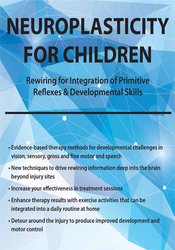

Studies show our brains can be rewired to enhance new learning. In some cases, it acts as an adaptive mechanism to compensate for lost function or maximize remaining function in the event of brain injury. As therapists, when we treat the causes and symptoms of these motor delays, we can utilize alternate brain pathways to improve the effects of therapy.
Neuroplasticity changes brain connections and hence, changes motor and cognitive functions. From congenital abnormalities to traumatic brain injuries, this course delivers new and exciting ideas on how to detour around damage and incorporate viable nervous system connections.
Learn how therapy can change the brain and how neuroplasticity can change the challenges in a child’s development. With Dr. Karen Pryor as your guide, you gain creative and evidence-based approaches to incorporate into a multisensory experience to drive home the importance of diverse and novel activities during treatment sessions.
Both high and low tones are discussed in depth. Video case studies will demonstrate changes before and after integrative neuroplasticity treatments. The therapy techniques learned in this one-day course can be easily integrated into the clinic or home the next day.
| File type | File name | Number of pages | |
|---|---|---|---|
| Manual - Neuroplasticity for Children (2.35 MB) | 91 Pages | Available after Purchase |

Karen Pryor, PhD, PT, DPT, CH, CFPS, has a doctorate in physical therapy and has practiced for 40 years in the field. Dr. Pryor is the owner of Health Sphere Wellness Center, an integrative therapy clinic in Nashville, Tennessee. Involved with early intervention in the birth-three population for over 30 years, she has developed neuroplasticity techniques that are used in a wide variety of settings, including homes, childcare centers, and school systems, to advanced pediatric therapy programs.
Dr. Pryor serves on several boards, including the Leadership Interagency Council for Early Intervention (2014-2019), a position to which she was appointed by Tennessee Governor Bill Haslam. In 2010, she received the President's Volunteer Service Award for her contributions to the advanced treatment of children from President Barack Obama. In addition to her work with children, Dr. Pryor has served as an adjunct professor at the Tennessee State University Occupational Therapy Assistant program. She is a clinical instructor for several universities and colleges. With her years of experience and passion for complete wellness, Dr. Pryor advances a more expansive view of how to integrate therapy throughout the lifespan by using neuroplasticity techniques.
Speaker Disclosures:
Financial: Karen Pryor is the owner of Health Sphere Wellness Center, LLC and is a field examiner for PDMS-3. She has employment relationships with Tennessee State University, the University of Tennessee at Chattanooga Physical Therapy School, the Daymar Physical Therapy Assistant School and the Volunteer State Community College. She is a paid consultant for Evergreen Certifications. Karen Pryor receives a speaking honorarium and recording royalties from PESI, Inc. She has no relevant financial relationships with ineligible organizations.
Non-financial: Karen Pryor is a reviewer with Tennessee Physical Therapy Association and American Physical Therapy Association. She is an Ambassador for National Down Syndrome Society.
Developmental Delays
How to Approach Treatments
Please wait ...